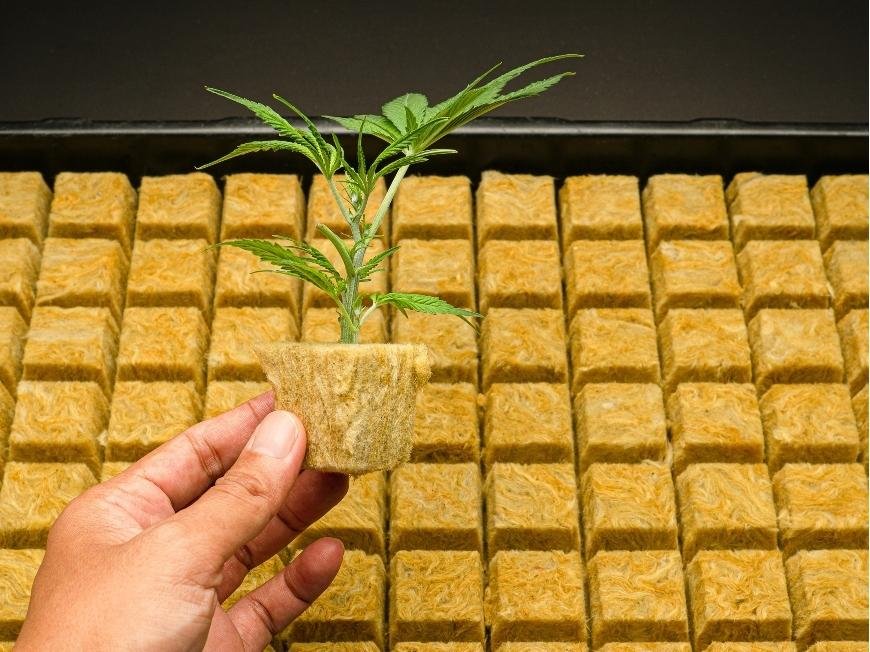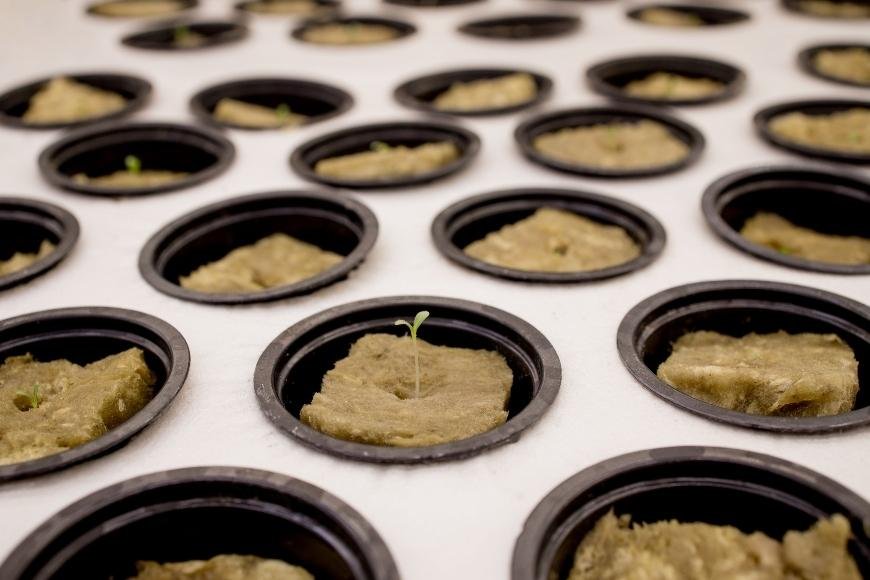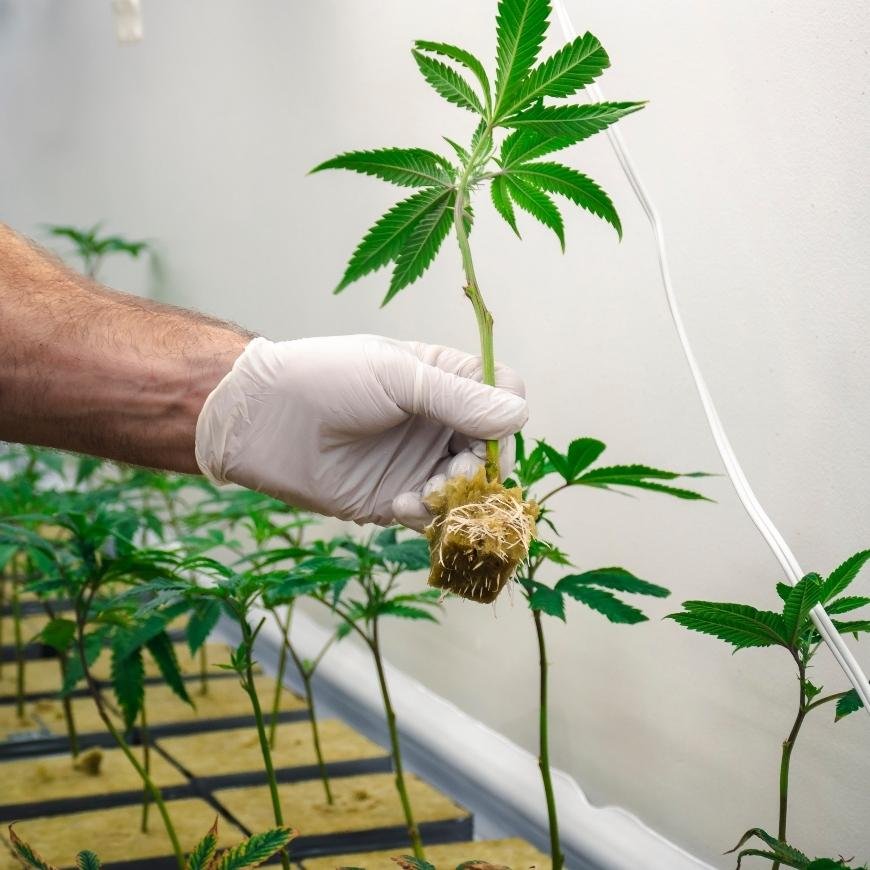Growing Cannabis in Rockwool
Discover the benefits of growing cannabis in Rockwool with our comprehensive guide, covering preparation, pH management, troubleshooting, and maximizing yields.

Growing cannabis in rockwool has become increasingly popular among young adults and recreational growers due to its numerous advantages. In this blog post, we will delve deep into the world of rockwool as a growing medium for cannabis plants.
Starting with understanding what rockwool is and how it can benefit your grow, we'll then move on to preparing rockwool for optimal plant growth. We'll also discuss managing pH levels and nutrient uptake when using this unique growing media.
Furthermore, we'll cover troubleshooting common issues that may arise while growing cannabis in rockwool, ensuring you're well-equipped to handle any challenges during the process. Finally, learn how to maximize yields by implementing best practices specifically tailored for cultivating marijuana in rockwool.
By the end of this comprehensive guide, you'll have all the knowledge necessary to successfully grow cannabis in rockwoold like an expert.
Table of Contents:
- Understanding Rockwool for Growing Cannabis
- Preparing Rockwool for Growing Cannabis
- Managing pH Levels and Nutrient Uptake with Rockwool
- Troubleshooting Common Issues with Rockwool
- Maximizing Yields with Rockwool
- FAQs in Relation to Growing Cannabis in Rockwool
- Conclusion
Understanding Rockwool for Growing Cannabis
It's made from melted basaltic rock and chalk, which are spun into fibers to create an absorbent material that can hold up to nine times its weight in water. Rockwool is easy to use, versatile, and provides excellent aeration and drainage properties for your plants. Rockwool's pH is neutral, meaning you don't need to adjust the soil or nutrient solution when utilizing it as a growing medium.
When preparing rockwool for growing cannabis, it’s important to ensure that you soak the cubes in warm water before planting seeds or clones. This will help them become fully saturated with moisture and provide the ideal environment for germination or root growth. You should also add nutrients directly into the soaking solution at this stage if necessary - just make sure they are specifically designed for use with hydroponic systems like rockwool.
Managing pH levels and nutrient uptake with rockwool requires some knowledge of basic chemistry principles such as how different elements interact with each other in solutions (such as acidic versus alkaline). To get started, test your water source’s pH level first - ideally this should be between 6-7 on the scale - then adjust accordingly by adding either acidifiers or bases depending on what kind of result you need (i.e., higher or lower). Additionally, monitor your nutrient solution regularly throughout the growth cycle to ensure proper nutrition delivery; too much nitrogen can cause stunted growth while too little could lead to deficiencies over time.
Keep an eagle eye out for pests such as fungus gnats, which may be attracted to the damp conditions around wet rocks. To nip this problem in the bud, regular cleaning practices should be implemented - such as washing off any visible larvae or eggs from surfaces nearby where they might breed undetected until later stages of development, when more damage has already been done. Keywords: Fungus Gnats, Damp Conditions, Cleaning Practices, Visible Larvae/Eggs
Having a good understanding of Rockwool for growing cannabis is essential to ensure healthy and successful yields. It's now time to set up Rockwool for cultivating cannabis and maximize your harvests.

Preparing Rockwool for Growing Cannabis
It's lightweight, provides excellent aeration and drainage, and can be reused multiple times. Preparing rockwool for use in your grow room is an important step to ensure that your plants have the best possible environment to thrive in. To ensure your plants are provided with an optimal environment for growth, you must take the necessary steps to ready rockwool for use in your grow room.
Soaking:
Rockwool cubes should always be soaked before planting seeds or clones into them. Before inserting seeds or clones, immerse the Rockwool cubes in a pH 5-6 liquid for no less than 10 minutes. This will help reduce any dust particles that may have settled on the surface of the cubes as well as provide moisture so that it’s easier to insert seeds or clones into them without damaging their delicate root systems.
Rinsing:
After soaking, rinse each cube thoroughly with fresh water until all traces of chlorine are gone from it (chlorine can cause nutrient deficiencies). Make sure not to over-rinse though – too much rinsing could remove beneficial microbes from the rockwool which would make it harder for your plants to absorb nutrients later on down the line.
pH Adjustment:
The last step is adjusting the pH level of each cube according to what type of plant you’re growing – different species require different levels depending on their needs (most cannabis varieties prefer a slightly acidic soil around 6-7). To adjust pH levels, add small amounts of either lime or sulfuric acid solution until you reach desired levels – test often using a digital meter.
Once prepared properly, rockwool makes an ideal growing medium for both experienced growers and newbies alike due to its versatility and ease of use - plus it's reusable which helps save money in the long term. With these simple steps you'll be ready to start cultivating some serious buds in no time.
Preparing Rockwool for Growing Cannabis is a critical step in the process of cultivating cannabis, as it provides optimal conditions for root growth and nutrient uptake. To ensure successful yields from your crop, managing pH levels and nutrient uptake with Rockwool must be taken into account when setting up your grow space.
Managing pH Levels and Nutrient Uptake with Rockwool
When growing cannabis with rockwool, pH levels and nutrient uptake are two of the most important factors to consider. Rockwool is a lightweight substrate made from melted basaltic rocks and chalk, which makes it an ideal choice for hydroponic cultivation. It has excellent water retention capabilities and provides good aeration for roots while providing optimal conditions for growth. Yet, if not managed correctly, it can lead to issues like inadequate nutrient uptake or too much alkalinity in the root area.
The first step to managing pH levels when using rockwool is to test the pH of your irrigation water before adding it to the system. The ideal range for cannabis plants is between 6-7pH; anything outside this range should be adjusted accordingly using either acidifiers or bases depending on whether you need to lower or raise the pH level respectively. Monitoring EC (electrical conductivity) levels during the growing cycle is essential to gauge how much nutrients have been taken up by your plants and make any necessary modifications.
Nutrient uptake can also be improved by ensuring that there's enough oxygen present in the root zone at all times – this can be achieved through proper aeration techniques such as air pumps or regular maintenance of your irrigation lines/reservoirs etc Additionally, try adding beneficial bacteria like mycorrhizae into your rockwool cubes before planting – these will help break down organic matter within soil/substrates making them easier for plant roots absorb essential nutrients more efficiently over time. Finally don't forget about temperature control: maintaining temperatures between 70-80°F during day cycles & 60-70°F during night cycles will ensure optimal nutrient absorption rates throughout each grow cycle too.
By following these simple tips, growers can maximize their yields while minimizing potential issues related to both pH levels and nutrient uptake when cultivating cannabis with rockwool substrates. Temperature control is key, as maintaining temperatures between 70-80°F during day cycles and 60-70°F during night cycles will ensure optimal nutrient absorption rates throughout each grow cycle. Additionally, adding beneficial bacteria like mycorrhizae into your rockwool cubes before planting can help break down organic matter within soil/substrates for easier plant root absorption of essential nutrients over time. With proper aeration techniques such as air pumps or regular maintenance of irrigation lines/reservoirs also aiding in oxygen presence in the root zone at all times, growers should have no trouble achieving successful harvests.
Managing pH levels and nutrient uptake with Rockwool is an important step in the process of growing cannabis, but it can be tricky. Now let's move on to troubleshooting common issues that may arise when using this medium for cultivation.

Troubleshooting Common Issues with Rockwool
Regrettably, rockwool can cause a variety of issues like pH instability and nutrient imbalance. To help ensure your plants thrive with rockwool, here’s what you need to know about troubleshooting these problems.
Nutrient Imbalance:
If the leaves of your plant start yellowing or wilting, this could be a sign of an imbalance in nutrients. Make sure you’re using the right fertilizer mix for your particular strain and check the EC (electrical conductivity) level of your solution regularly to make sure it falls within the optimal range for cannabis growth (1-2 mS/cm). Additionally, use reverse osmosis or distilled water instead of tap water to avoid any additional contaminants from affecting your nutrient balance.
PH Fluctuations:
The ideal pH range for cannabis is between 6-7; anything outside this range can lead to nutrient lockout where essential minerals aren't absorbed by the plant roots properly. You should test both soil and irrigation solutions regularly with a pH meter or litmus paper strips so that you can adjust accordingly if necessary - adding lime powder will raise pH levels while sulfur will lower them back down again.
Ensure adequate ventilation, but direct fans away from the cubed media to maintain optimal humidity levels without over-drying the substrate. Keep a hawk's eye on your grow room setup and nip any mold growth in the bud before it spreads further.
Troubleshooting common issues with Rockwool is a crucial part of achieving the highest yields possible. To further maximize your results, it's important to understand how to properly use Rockwool in order to achieve maximum yield potential.
Maximizing Yields with Rockwool
Rockwool is an excellent growing medium for cannabis, and when used correctly it can yield impressive results. To maximize yields with rockwool, growers should focus on two main factors: pH levels and nutrient uptake.
The optimal pH level for rockwool-grown cannabis is between 5.5 and 6.5. If the pH level deviates from this range, nutrient uptake will be inhibited or even toxic to your plants. To ensure that your pH remains within the correct range, test regularly using a reliable testing kit or meter and adjust as needed by adding acid or base solutions to the water you use to irrigate your crop.
Nutrient uptake is also key in maximizing yields with rockwool-grown cannabis crops. Rockwool cubes come preloaded with nutrients but they won’t last forever—you'll need to supplement them throughout the growth cycle by feeding your plants liquid fertilizer at regular intervals according to manufacturer's instructions for best results.
Finally, make sure you're providing adequate air circulation around each plant's root system; otherwise oxygen cannot reach all parts of the cube which can lead to root rot or other problems down the line that could reduce overall yield potentials significantly. Use fans in combination with air pumps whenever possible and consider adding additional ventilation holes into each cube if necessary - just be sure not to overdo it.
To troubleshoot any issues related to rockwool growing mediums quickly and efficiently, it is important to maintain detailed records of everything from watering schedules and fertilizer applications right down through temperature readings taken throughout various stages of growth. This will provide something concrete upon which to compare current conditions against past performance metrics in order pinpoint exactly where things are going wrong (if anything). Doing so will help minimize losses due unforeseen events such as pest infestations or sudden changes in climate while simultaneously increasing overall yield potentials across entire batches of plants grown using rock wool substrates.
FAQs in Relation to Growing Cannabis in Rockwool
Is rockwool good for cannabis?
Yes, rockwool is a great medium for cannabis growth. It's lightweight and easy to handle, plus it provides excellent aeration and drainage. The material is also pH neutral which makes it ideal for growing many types of plants including cannabis. Additionally, rockwool can hold onto moisture longer than other substrates like soil or coco coir so your plant will have more consistent access to water during the grow cycle. Rockwool is definitely an effective choice when growing cannabis indoors or outdoors.
How long does it take cannabis to sprout in rockwool?
Cannabis typically sprouts in rockwool within 5-7 days. The amount of time it takes for cannabis to germinate depends on the temperature and humidity levels, as well as the quality of the rockwool. For ideal germination, temperatures should range from 70-85°F (21-29°C) with a humidity level of 80%. If these conditions are met, then cannabis seeds will usually start to sprout within 1 week. Monitoring the progress of your cannabis plants during this time is essential to ensure that they remain hydrated, neither too dry nor overly wet.
What is the proper pH for cannabis in rockwool?
The proper pH for cannabis in rockwool is between 5.5 and 6.2. To ensure the best growth and nutrition, it is advised to keep the pH level below 6.0 while avoiding any fluctuations beyond 7.0 for optimal results. It's also recommended that you test your soil regularly with an accurate digital meter to ensure optimal growing conditions are maintained throughout the life cycle of your plants.
Is rockwool better than coco coir for cannabis?
It depends on the desired outcome. Rockwool is an inert, hydroponic growing medium that retains moisture and offers excellent aeration for roots. Coco coir is a natural soil amendment made from coconut husks that helps retain water while providing good drainage and air circulation for plant growth. Both can be used to grow cannabis, but rockwool may provide better results in terms of faster root development and higher yields due to its ability to hold more oxygen around the roots than coco coir. Ultimately, it comes down to personal preference as both media have their pros and cons when it comes to cultivating cannabis plants successfully.
Conclusion
Rockwool is a great medium for growing cannabis, but it does require extra attention and effort. With proper preparation, pH levels and nutrient management, growers can maximize their yields with rockwool while avoiding common issues associated with this type of growing method. If you're looking to take your cannabis cultivation game up a notch then consider giving rockwool a try – the rewards are worth the effort.




















































































































